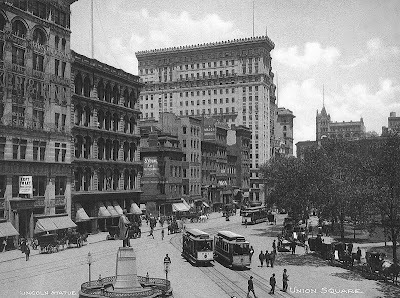DeAnna Cameron's Blog, page 17
March 5, 2012
My Huge Publication Celebration Contest Kicks Off Today!
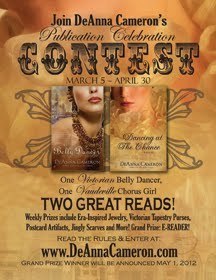 What do you do when you have two book releases in two months? Celebrate, of course! And I'm doing it by giving stuff away. Lots of stuff. Stuff that the Victorian belly dancers in THE BELLY DANCER would love, and stuff that the vaudeville dancers in DANCING AT THE CHANCE would crave. There's also a grand prize that anyone would love: the winner's choice of a brand new Nook or Kindle.*
What do you do when you have two book releases in two months? Celebrate, of course! And I'm doing it by giving stuff away. Lots of stuff. Stuff that the Victorian belly dancers in THE BELLY DANCER would love, and stuff that the vaudeville dancers in DANCING AT THE CHANCE would crave. There's also a grand prize that anyone would love: the winner's choice of a brand new Nook or Kindle.*Wanna find out how you can collect entries for the weekly prizes and the grand prize? Visit www.DeAnnaCameron.com and follow the Publication Celebration Contest link.
Good luck!
*Yes, there are some boring rules & restrictions. Check out the contest details to see which two $99-value models are being offered.
Published on March 05, 2012 08:52
March 4, 2012
Goodreads Book Giveaway
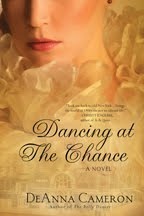 Goodreads has copies of "Dancing at the Chance" up for grabs. Yup, you can win it even before you can buy it -- how cool is that? But you'll have to be quick. The contest ends March 9.
Goodreads has copies of "Dancing at the Chance" up for grabs. Yup, you can win it even before you can buy it -- how cool is that? But you'll have to be quick. The contest ends March 9.Here's the link:
http://www.goodreads.com/book/show/12449153-dancing-at-the-chance
Good luck!
P.S. When you're on the page, don't forget to add the book to your "to-read" pile :)
Published on March 04, 2012 10:25
March 2, 2012
Friday Flickers: Lillian Russell in 1913 and in Color
When you look back on the brightest stars of vaudeville's heyday, no one shines brighter than Lillian Russell. The woman was a beloved actress and singer who was as well known for her extravagance and paramours as she was for her stage accomplishments. She would have been in her early 50s in this surviving 16-second clip from "How to Live 100 Years," but even here you can see what an exceptional beauty she was.
Thanks to atqui for posting!
Enjoy!
MUSIC ALERT: Hit the "mute" button if you prefer no sound.

Thanks to atqui for posting!
Enjoy!
MUSIC ALERT: Hit the "mute" button if you prefer no sound.
Published on March 02, 2012 10:14
February 24, 2012
Flicker Friday: The Very First Motion Pictures
With the Academy Awards around the corner and everyone in a mood to celebrate the best of modern movie-making, it's interesting to look back to see just how far we've come since the very first films were made more than a century ago. This video from KKD1247 introduces viewers to Eadweard Muybridge's galloping horse, from 1878, and the running bison, from 1883. Both films use Muybridge's method of showing still photographs in rapid sequence. The video follows with Monkeyshines, no. 1 and no. 2, which are film fragments of a man making large gestures, shot in 1889-90 using Thomas Edison's experimental horizontal-feed kinetoscope camera and viewer.
Do you think Muybridge or Edison could have imagined the slick feature films we take for granted today? Probably not. But it's inspiring to see how far the human imagination can go once it gets a nudge in the right direction.
Enjoy!

Do you think Muybridge or Edison could have imagined the slick feature films we take for granted today? Probably not. But it's inspiring to see how far the human imagination can go once it gets a nudge in the right direction.
Enjoy!
Published on February 24, 2012 07:39
February 17, 2012
Flicker Friday: Cohen's Fire Sale
Cohen's Fire Sale is a silent film Edwin S. Porter was working on in mid-1907 that the hero in DANCING AT THE CHANCE observes during his visit to Edison's Skylight Studios. Watching it today, it's difficult to see just how advanced this film was for its time. It features lots of over-the-top acting by a caricature-esqe cast against false backgrounds that sometimes even seem to wobble, as though inadvertently bumped by a crew member during the take. But there are also some outdoor scenes -- on the street and at the wharf -- where you get hints of the techniques Porter employed that laid an all-important foundation that allowed moviemaking to evolve into what we consider good moviemaking today.
Also, anyone with an interest in period costumes might appreciate the ladies' fashion contained here -- especially the hats!
MUSIC ALERT: A piano track accompanies the silent film

Also, anyone with an interest in period costumes might appreciate the ladies' fashion contained here -- especially the hats!
MUSIC ALERT: A piano track accompanies the silent film
Published on February 17, 2012 09:14
February 10, 2012
Flicker Friday: The Enchanted Drawing
This fun flicker comes from the Library of Congress's collection of Edison films and stars J. Stuart Blackton, who was a cartoonist for the New York Evening World at the time. It begins with Blackton drawing upon white paper on an easel, but with some stop-camera tricks, the viewer is treated to some of the earliest examples of cinematic special effects, as the drawn subjects seem to come alive right before your eyes.
This is one of my favorites flicker discoveries, so I made sure it was one the DANCING AT THE CHANCE heroine discoveres in her Old New York neighborhood kinetoscope parlor.
Enjoy!
MUSIC ALERT: There is some, so proceed accordingly.
Early-cinema history buffs might be interested in this. It's the film's description from the Edison films catalog:
Upon a large sheet of white paper a cartoonist is seen at work rapidly sketching the portrait of an elderly gentleman of most comical feature and expression. After completing the likeness the artist rapidly draws on the paper a clever sketch of a bottle of wine and a goblet, and then, to the surprise of all, actually removes them from the paper on which they were drawn and pours actual wine out of the bottle into a real glass. Surprising effects quickly follow after this; and the numerous changes of expression which flit over the face in the sketch cause a vast amount of amusement and at the same time give a splendid illustration of the caricaturist's art. 100 feet. 15.00.
This is one of my favorites flicker discoveries, so I made sure it was one the DANCING AT THE CHANCE heroine discoveres in her Old New York neighborhood kinetoscope parlor.
Enjoy!
MUSIC ALERT: There is some, so proceed accordingly.
Early-cinema history buffs might be interested in this. It's the film's description from the Edison films catalog:
Upon a large sheet of white paper a cartoonist is seen at work rapidly sketching the portrait of an elderly gentleman of most comical feature and expression. After completing the likeness the artist rapidly draws on the paper a clever sketch of a bottle of wine and a goblet, and then, to the surprise of all, actually removes them from the paper on which they were drawn and pours actual wine out of the bottle into a real glass. Surprising effects quickly follow after this; and the numerous changes of expression which flit over the face in the sketch cause a vast amount of amusement and at the same time give a splendid illustration of the caricaturist's art. 100 feet. 15.00.
Published on February 10, 2012 07:59
February 8, 2012
Novel Inspiration: Images of Old New York
When I'm working on a novel, I collect images of people for character reference, but I also collect images of places -- and collecting images of Old New York was essential to the writing of DANCING AT THE CHANCE. At the turn of the last century, New York was such a different place than it is today, and old photos were the surest way to fact-check. At a glance, you can see what buildings were there, and which were not. How people moved around (by horse-drawn conveyances primarily, but automobiles were beginning to appear by 1907). How people dressed. And generally get a feel for the place.
I have several books of old photographs (and I list a few of the most influential ones in the novel's Historical Note), but the Internet now makes many, many of these old images available to anyone with access and a sense of curiosity.
I'm collecting some of my favorites over on my "Old New York" Pinterest board, which you can find here.
And I've posted a few others below.
I hope you'll enjoy them as much as I do.
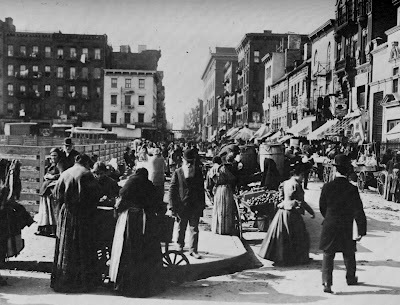 Norfolk and Hester Street, circa 1898
Norfolk and Hester Street, circa 1898
 Hester Street, 1903
Hester Street, 1903 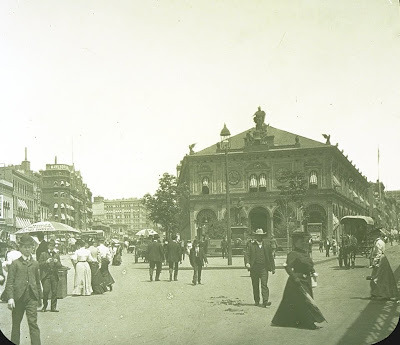
Herald Square,circa 1900


I have several books of old photographs (and I list a few of the most influential ones in the novel's Historical Note), but the Internet now makes many, many of these old images available to anyone with access and a sense of curiosity.
I'm collecting some of my favorites over on my "Old New York" Pinterest board, which you can find here.
And I've posted a few others below.
I hope you'll enjoy them as much as I do.
Union Square, 1906
 Norfolk and Hester Street, circa 1898
Norfolk and Hester Street, circa 1898 Hester Street, 1903
Hester Street, 1903 
Herald Square,circa 1900

Common newsstand, circa 1902
Photos are all in the public domain and available at Wikimedia Commons.
Published on February 08, 2012 07:49
February 3, 2012
Flicker Friday: Levi & Cohen, the Irish Comedians
Now here's some old-fashioned comedy. In this 1903 clip, Levi & Cohen, the Irish Comedians poke fun at ethnic stereotypes, as well as vaudeville itself. The best part of the act is these two comedians getting panned by the audience. Thanks to Brent Eades for producing the video, and AntiqueFilm for posting it.
WARNING: The clip includes a music track (Porcupine Rag, 1909)
Enjoy!

WARNING: The clip includes a music track (Porcupine Rag, 1909)
Enjoy!
Published on February 03, 2012 07:59
February 1, 2012
Novel Inspiration: Envisioning the Characters
I could write about my inspirations for the characters in DANCING AT THE CHANCE, but wouldn't it be more fun to see them for yourself? Well, you can because I've put together a Character Inspiration board over at Pinterest (my new favorite site!).
Come on over and have a look. I'll bring the tea.
http://pinterest.com/deannacameron/
Come on over and have a look. I'll bring the tea.
http://pinterest.com/deannacameron/
Published on February 01, 2012 07:39
January 29, 2012
Recipe: Not-So-Traditional Scotch Broth
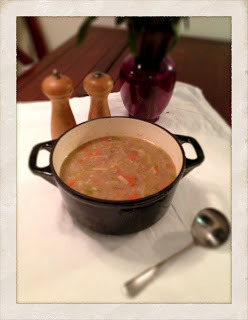 I've never had an occasion to try Scotch Broth, but it is one of the dishes that connects the heroine of DANCING AT THE CHANCE with her Scottish heritage, so I added it to my family's Burns Night menu this year.
I've never had an occasion to try Scotch Broth, but it is one of the dishes that connects the heroine of DANCING AT THE CHANCE with her Scottish heritage, so I added it to my family's Burns Night menu this year.I wanted a traditional version, so I started with a recipe I found in "The Boston Cooking-School Cook Book," published in 1896. It calls for three pounds of mutton; a half-cup of barley; and a quarter-cup each of carrot, turnip, onion and celery; and salt and pepper.
Adjustments began almost immediately. At the supermarket, I found only leg of lamb and ground lamb. So instead of three pounds of mutton, I came home with a pound and a half leg of lamb.
I cut the meat into one-inch cubes, put it in a stock pot with the bone and six cups of water, brought it to a boil, then let it simmer, covered. The recipe didn't call for it, but I couldn't resist adding a bay leaf and a wire-mesh ball filled with five peppercorns, three whole allspice berries and a half-teaspoon of thyme to boost the flavor.
After an hour and a half, I removed the meat and set it aside, added the pearl barley, which had been soaking overnight, as well as two cups water and a cup each of chopped onion, carrot and celery. I left out the rutabaga, since I needed all that I had for the clapshot I was also making for dinner.
After a couple more hours of simmering, I checked on the pot and, I'll be honest, I wasn't thrilled with the gamey lamb smell.
I pulled out the bone, cut up the white and light green parts of three leeks I found in the fridge, sautéed them in butter, and added them to the pot. I simmered for another hour and was much happier with the aroma and the taste.
I took out the wire-mesh ball with the seasonings and returned the cooked meat to the pot about ten minutes before we served.
In the end, the soup made for a nice addition to the Burns Night menu, which this year included a veggie haggis (and the requisite reading of Burns' Address to a Haggis), a creamy clapshot and the traditional whisky toast.
THE CAMERON FAMILY'S NOT-SO-TRADITIONAL SCOTCH BROTH
1 1/2 pounds lamb leg
Bay leaf
5 peppercorns
3 whole allspice
1/2 teaspoon thyme
1/2 cup pearl barley, soaked overnight
1 cup onion
1 cup chopped carrot
1 cup celery
2 tablespoons butter
3 leeks, white and light green parts chopped
Cut the meat into 1-inch cubes and place in a pot with the bone, 8 cups of water and a bay leaf. Place the peppercorns, allspice and thyme to a wire-mesh ball or cheesecloth satchel and add that to the pot. Bring to a boil, then simmer covered for 1 1/2 hours, skimming away any frothy residue. Remove the meat and store in the fridge, but leave the bone. To the pot, add the pearl barley, 2 cups water, onion, carrot and celery. Saute the leek in butter and add that to the pot as well. Simmer covered for two hours. About ten minutes before serving, remove the bay leaf, peppercorns, allspice and thyme, and add the meat that was set aside earlier. Yields four generous servings
Published on January 29, 2012 20:02

